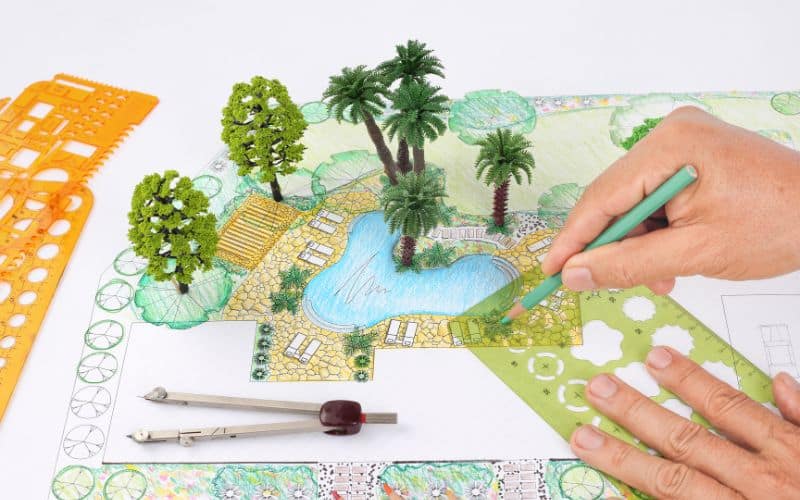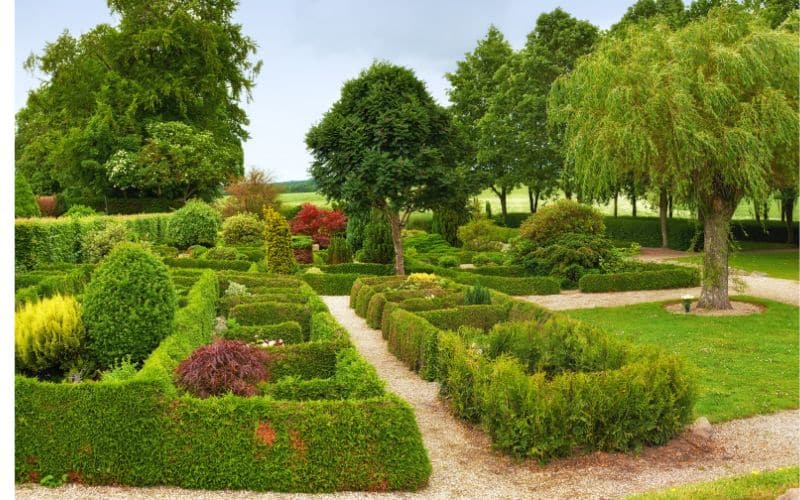
What is Landscape Planning and Its Benefits
Landscape planning involves designing and crafting outdoor spaces that are visually pleasing, functional, and sustainable. With its focus on beautifying spaces while providing green sanctuaries for rest and recreation, landscape planning goes beyond aesthetic appeal and positively impacts the quality of life.
What are The Key Principles of Landscape Planning
Balance and Proportions: Symmetrical arrangements mirror the layout and elements on either side of a central axis, providing a sense of order and formality. On the other hand, asymmetrical arrangements rely on the careful positioning of elements in different sizes, shapes, or colors to create balance while maintaining a more natural and informal atmosphere.
Focal Points and Emphasis: A well-designed landscape includes striking elements that capture and maintain the viewer’s attention. Focal points can take many forms, from attention-grabbing structures and unique plants to beautifully designed water features. By incorporating arresting elements as central points of interest, landscape planners can guide the viewer’s focus and provide a sense of intrigue throughout the space.
Unity and Harmony: The key to a successful landscape lies in its cohesive and visually engaging design. Unity is achieved by applying a consistent design language, selecting elements like plants and hardscapes that share a common visual thread. By thoughtfully choosing complementary features, landscape planners can create an outdoor space where each contributes to a harmonious and well-orchestrated design.
Contrast and Variety: A visually interesting landscape relies on the interplay between contrasting elements. Variation in textures, colors, and shapes prevents monotony and can elevate an outdoor space.
Function and Sustainability: A successful landscape considers both functionality and sustainability. An environmentally conscious approach takes into account factors such as native plant selections, water-saving techniques (e.g., drip irrigation or incorporating drought-tolerant plants), and energy-efficient structures (e.g., using solar-powered lighting).

Choosing the Right Landscape Elements
Plants: To create a thriving landscape, carefully choose the right trees, shrubs, flowers, and groundcovers. Assess the climate, soil conditions, and design requirements of your landscape to select plants that will flourish in your particular environment.
Hardscape Materials: Hardscape elements like paving, walls, and edging play a significant role in shaping your landscape. They provide structure and contribute to defining spaces or specific areas. Choose hardscape materials that complement the overall design aesthetic, considering factors such as color, texture, and durability.
Outdoor Structures: Adding outdoor structures like pergolas, arbors, or trellises can provide various functional benefits, such as shade and support for climbing plants, while enhancing the visual appeal of your landscape. When selecting structures, consider the overall design, style, and material of your landscape to ensure a cohesive and unified look.
Water Features: Integrating water elements such as ponds, fountains, or streams can elevate your landscape’s ambiance by introducing a tranquil and therapeutic aspect. While water features could range from simple bubbling fountains to more elaborate pond designs, ensuring they complement the landscape’s overall style and scale is vital.
Lighting and Visual Accents: Boost your landscape’s functionality and aesthetic appeal by strategically placing lights and visual accents such as sculptures, decorative pots, or garden ornaments. Effective landscape lighting not only enhances safety and usability but also contributes to creating a dramatic night time atmosphere.
Incorporating Natural Elements into Your Landscape
Native Plants and Vegetation: Using native plants in your landscape design supports local biodiversity, promotes eco-friendly habitats, and conserves resources. Native plants are adapted to the local climate and soil, requiring less maintenance, water, and fewer chemicals while providing food and shelter to local wildlife.
Natural Features Preservation: By embracing and enhancing existing natural features like hills, rocks, and waterways, you can create an organic, environmentally-friendly landscape with unique character.
Wildlife-friendly Design: Creating habitat-friendly landscapes encourages local fauna, such as birds, pollinators, and small mammals, to visit and thrive in your outdoor space. Cultivating native species, providing shelter, and maintaining water sources support a diverse range of local wildlife while enriching the ecosystem and creating a dynamic, living landscape.
Eco-friendly Materials and Practices: Opt for environmentally-friendly materials and practices in your landscape design. Examples include using permeable paving or solar-powered lighting for a more sustainable space, minimizing pesticide usage, and implementing water conservation methods.
Designing Harmonious Landscapes

Cohesive and Aesthetically Pleasing Landscape Plans
To achieve a harmonious design, create interconnected spaces that flow seamlessly together using a consistent color palette, textures, scale, and layout. Ensure that all elements complement each other, contributing to a unified and visually captivating landscape.
Multi Layered Plantings
Enhance visual interest and add depth by arranging plants in layers, starting with taller trees, followed by shrubs, perennials, and groundcovers. This layering technique creates a sense of depth and an engaging visual effect that captures the eye.
Integrating Hardscape Elements
Blend hardscape materials, like paving, walls, and edging, with the natural landscape by using complementary designs and plantings. Thoughtful integration of these features creates a seamless transition between built and natural elements, contributing to a harmonious landscape.
Smooth Transitions Between Spaces
Create smooth and seamless transitions between various areas of your landscape by designing imaginative paths, archways, or elevation changes. Guide the viewer’s eye through natural progressions from one space to another, enhancing the overall flow and visual continuity of your landscape.
Tips for Successful Landscape Planning
Understanding Site Conditions: Evaluate site-specific factors like sun exposure, soil composition, and drainage to make informed decisions about plant and material selections. Adhering to local zoning regulations ensures a compliant and well-designed landscape.
Working with Landscape Professionals: Partner with landscape architects, designers, or contractors to create well-balanced and expertly crafted designs. Their expertise and technical knowledge can provide valuable guidance in achieving your desired landscape outcome.
Adapting to Budget and Timeline: Design your landscape with adaptability in mind by prioritizing elements based on budget and time constraints. Tackle essential items first, and consider adding secondary features later when resources permit. Planning with flexibility ensures a successful and enjoyable project.
Regular Maintenance Practices: Invest time and effort in ongoing maintenance to preserve the beauty and functionality of your landscape. Regular tasks like weeding, pruning, watering, and fertilizing ensure that your landscape remains visually appealing and promotes overall health.
Conclusion
Creating a harmonious landscape plan requires balancing visual appeal, functionality, and sustainability. By incorporating a diverse range of elements and principles, you can craft an outdoor haven that brings you closer to the serene beauty of nature.

Landscape Planning FAQs
What are examples of focal points in landscape design?
A prominent water feature, a striking tree, or an eye-catching piece of artwork.
Why choose native plants for landscape planning?
Native plants adapt better to local climates and soil, require minimal maintenance, conserve water, and support local wildlife.
What are some guidelines for eco-friendly landscape design?
Incorporate native plants, minimize water use, reduce lawn areas, avoid harmful chemicals, and recycle yard waste.
How can you maintain a healthy landscape?
Invest in regular maintenance tasks like weeding, pruning, watering, and fertilizing to keep your landscape visually pleasing and promote its overall health.
What can I do to maintain a healthy landscape?
Invest in regular maintenance tasks, such as weeding, pruning, watering, and fertilizing, to keep your landscape looking its best and maintaining overall health.
Colin Macmillan is a seasoned entrepreneur and the CEO of Riverwood Landscape, a leading landscaping company based in Canada. He has been at the helm of the company since leaving high school, demonstrating his strong leadership skills and business acumen.
Colin’s expertise lies in various aspects of landscaping, including lawn care, interlocking, sod installation, and commercial maintenance. His hands-on approach and dedication to the craft have been instrumental in building Riverwood Landscape into a reputable brand.
One of his most notable achievements is the creation of a successful landscape franchise that services multiple locations. This accomplishment underscores his strategic thinking and ability to scale operations effectively.
Colin has also had the privilege of working with Guelph Hospital for landscaping and maintenance, a testament to the trust and reliability that his company has earned over the years.
His professional mission is to offer the best services and experiences for customers, a goal that he tirelessly pursues. Colin’s commitment to excellence and customer satisfaction continues to drive the growth and success of Riverwood Landscape.








